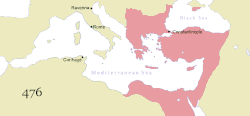
Back الإمبراطورية البيزنطية تحت حكم السلالة الكومنينية Arabic بیزانس ایمپراتورلوغو (کومنوس سولالهسی) AZB Imperi Romà d'Orient sota la dinastia dels Comnens Catalan Byzantská říše v době Komnenovců Czech Βυζαντινή Αυτοκρατορία υπό τη Δυναστεία των Κομνηνών Greek Imperio bizantino bajo la dinastía de los Comnenos Spanish Dynastie des Comnènes French Բյուզանդիան Կոմնենոսների օրոք Armenian Բիւզանդիան Քոմնենոսներու Թագաւորութեան Ժամանակ HYW Impero bizantino durante la dinastia comnena Italian
Byzantine Empire
| |||||||||||||
|---|---|---|---|---|---|---|---|---|---|---|---|---|---|
| 1081–1185 | |||||||||||||
 The Byzantine Empire at the death of Manuel I Komnenos in 1180. | |||||||||||||
| Capital | Constantinople | ||||||||||||
| Common languages | Greek, Armenian, Aromanian, Old Bulgarian, Old Anatolian Turkish and other South Slavic languages | ||||||||||||
| Religion | Eastern Orthodox Church | ||||||||||||
| Government | Semi-feudal monarchy | ||||||||||||
| Emperor | |||||||||||||
• 1081–1118 | Alexios I | ||||||||||||
• 1118–1143 | John II | ||||||||||||
• 1143–1180 | Manuel I | ||||||||||||
• 1180–1183 | Alexios II | ||||||||||||
• 1183–1185 | Andronikos I | ||||||||||||
| History | |||||||||||||
| 26 August 1071 | |||||||||||||
• Coronation of Alexios I | 4 April 1081 | ||||||||||||
• The First Crusade is declared | 27 November 1095 | ||||||||||||
| 17 September 1176 | |||||||||||||
• Deposition of Andronikos I | 12 September 1185 | ||||||||||||
| |||||||||||||
| History of the Byzantine Empire |
|---|
 |
| Preceding |
| Early period (330–717) |
| Middle period (717–1204) |
| Late period (1204–1453) |
| Timeline |
| By topic |
|
|
The Byzantine Empire was ruled by emperors of the Komnenos dynasty for a period of 104 years, from 1081 to about 1185. The Komnenian (also spelled Comnenian) period comprises the reigns of five emperors, Alexios I, John II, Manuel I, Alexios II and Andronikos I. It was a period of sustained, though ultimately incomplete, restoration of the military, territorial, economic and political position of the Byzantine Empire.
Byzantium under the Komnenoi played a key role in the history of the Crusades in the Holy Land, while also exerting enormous cultural and political influence in Europe, the Near East, and the lands around the Mediterranean Sea. The Komnenian emperors, particularly John and Manuel, exerted great influence over the Crusader states of Outremer, whilst Alexios I played a key role in the course of the First Crusade, which he helped bring about.
Moreover, it was during the Komnenian period that contact between Byzantium and the 'Latin' Christian West, including the Crusader states, was at its most crucial stage. Venetian and other Italian traders became resident in Constantinople and the empire in large numbers (60–80,000 'Latins' in Constantinople alone), and their presence together with the numerous Latin mercenaries who were employed by Manuel in particular helped to spread Byzantine technology, art, literature and culture throughout the Roman Catholic west. Above all, the cultural impact of Byzantine art on the west at this period was enormous and of long lasting significance.
The Komnenoi also made a significant contribution to the history of Asia Minor. By reconquering much of the region, the Komnenoi set back the advance of the Turks in Anatolia by more than two centuries. In the process, they planted the foundations of the Byzantine successor states of Nicaea, Epirus and Trebizond. Meanwhile, their extensive programme of fortifications has left an enduring mark upon the Anatolian landscape, which can still be appreciated today.[1]
- ^ C. Foss & D. Winfield, Byzantine fortifications, an introduction